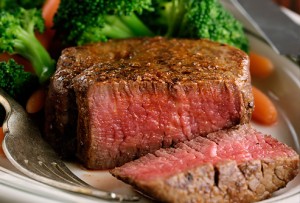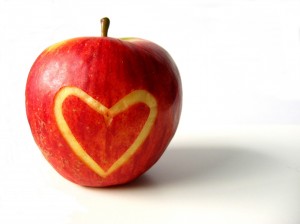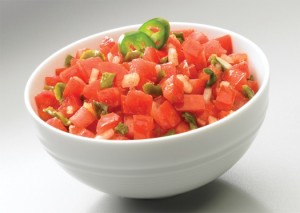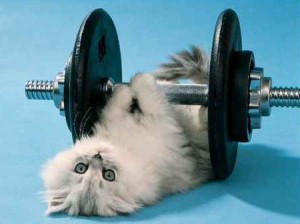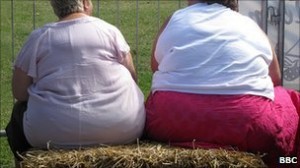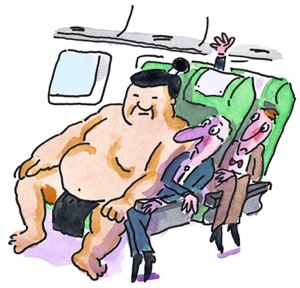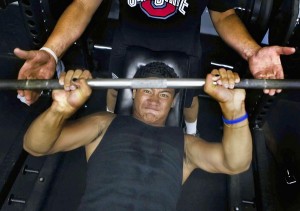
Weight training can build muscle, but that doesn't mean you start burning calories like a Hummer burns gasoline. (Mark Boster, Los Angeles Times / May 16, 2011)
Sorry to say, but gaining muscle doesn’t make your metabolism skyrocket. Put down that Haagen-Dazs.
Whenever I hear about some amazing way to boost resting metabolism, my male-bovine-droppings detector goes berserk. Take the perennially popular one stating that 1 pound of muscle burns an extra 50 calories a day while at rest — so if you gain 10 pounds of muscle, your resting metabolic rate (RMR) soars by an extra 500 calories each day.
Awesome!
And also drivel. I’m more likely to believe bears use Porta-Potties and the pope is a Wiccan.
Though its origins are uncertain, any number of fitness magazines have made the “50 calories per pound of muscle” statement. Popular weight-loss gurus have jumped on the muscle-building-as-panacea-for-fat-loss bandwagon as well.
Dr. Mehmet Oz said in a 2007 presentation to the National Cosmetology Assn., “Muscle burns about 50 times more calories than fat does.” Bill Phillips wrote in his bestselling “Body for Life” that, “through resistance training, you can also significantly increase your metabolic rate … weight training is even superior to aerobic exercise for people who want to lose weight.” And Jorge Cruise wrote in “8 Minutes in the Morning” that his exercise regimen “will help you firm up five pounds of lean muscle within the first few weeks, allowing your body to burn an extra 250 calories per day.”
Gain 5 pounds of muscle in the first few weeks? If only.
Let’s use me as an example. I’ve added about 20 pounds of muscle through several years of hard weightlifting. If this myth holds true, I’ve gained 1,000 calories of additional resting metabolic rate each day. Well, I keep pretty close tabs on my energy balance, and I can guarantee this isn’t happening. Too bad, because those extra 1,000 calories a day could translate to a gluttonous feast of salt-and-vinegar potato chips and cookie dough ice cream.
Beyond making me the go-to guy for opening pickle jars, what other contributions are made by that extra muscle? To get the answer, I spoke with Claude Bouchard of the Pennington Biomedical Research Center in Baton Rouge, La., who has authored several books and hundreds of scientific papers on the subject of obesity and metabolism. Bouchard told me that muscle, it turns out, makes a fairly small contribution to RMR.
“Brain function makes up close to 20% of RMR,” he said. “Next is the heart, which is beating all the time and accounts for another 15-20%. The liver, which also functions at rest, contributes another 15-20%. Then you have the kidneys and lungs and other tissues, so what remains is muscle, contributing only 20-25% of total resting metabolism.”
So, if you slave at weightlifting and increase your muscle mass by an ambitious 20%, this translates into only a 4% to 5% increase in RMR. Since a 200-pound man has an RMR of roughly 2,000 calories, a 20% increase in muscle mass equals only an 80- to 100-calorie increase.
For fun, let’s run the numbers in even more detail, adding the role played by body fat. Bouchard sent me a follow-up email explaining that — based on the biochemical and metabolic literature — a pound of muscle burns six calories a day at rest and a pound of fat burns about two calories a day, contrary to what the myth states. So, muscle is three times more metabolically active at rest than fat, not 50 times.
Again, let’s use me as a guinea pig and do the math. The 20 pounds of muscle I’ve gained through years of hard work equate to an added 120 calories to my RMR. Not insignificant, but substantially less than 1,000. However, I also engaged in a lot of aerobic activity and dietary restriction to lose 50 pounds of fat, which means I also lost 100 calories per day of RMR. So, post-physical transformation, my net caloric burn is only 20 calories higher per day, earning me one-third of an Oreo cookie. Bummer.
Don’t think I’m down on weights; I lift four hours a week because it’s awesome. It makes me stronger, increases my bone density and improves the strength of my connective tissues. It hardens me against injury from other activities. And my wife says that it makes me pretty from the neck down.
Bill Phillips told me through an assistant that weightlifting is better for fat loss because “each new pound of muscle tissue increases chronic total energy expenditure/metabolism” and that “aerobic exercise alone does not offer this benefit.” However, a sizable body of research shows that intense aerobic activity like running burns twice as many calories per hour as hard weightlifting, and the metabolic boost from added muscle is not nearly enough to compensate for this difference.
(I should note that Phillips and I are on the same general side in that we both recommend a combination of aerobic training and weightlifting.)
But wait! When you factor in “after burn,” couldn’t weightlifting still be some miracle calorie-consumer? Sorry, Conan, but after-burn — technically called excess post-exercise oxygen consumption, or EPOC — does exist, but only to a small degree. As I’ve covered in an earlier column, the EPOC of interval training is insignificant. And the same holds true for weightlifting.
A quick scan of the research:
• In 1995, researchers at the University of Limburg in the Netherlands published a study in Medicine & Science in Sport & Exercise on 21 male subjects and determined that weight-training “has no effect” on RMR.
• In 1994, researchers at the Royal Veterinary and Agricultural University in Denmark compared 10 bodybuilders with 10 lean (you are so puny!) subjects. Published in the American Journal of Clinical Nutrition, the report found that intense weight-lifting did not result in any measurable EPOC.
• In 1992, researchers from the University of Texas at Austin compared intense weightlifting with intense aerobic exercise on 47 males and reported in the American Journal of Clinical Nutrition that “RMR did not significantly change after either training regimen.”
Certainly the act of weightlifting burns calories, but intensity makes a big difference. In 1988, researchers at the University of Alabama in Birmingham published a study in the Journal of Applied Sport Science Research that used 17 subjects to compare the caloric burn of light versus heavier weightlifting.
When accounting for the same total volume of weight lifted (lifting 100 pounds three times is the same “volume” as lifting 300 pounds once), they found that when people lifted at 80% intensity, they burned three times as much energy as lifting at 20% intensity.
All of this, in any case, ignores the most important part of weight loss: what you eat. “The bottom line is that weight loss is 90% about diet,” obesity researcher Dr. Sue Pedersen, a specialist in endocrinology and metabolism in Calgary, told me. “The studies show that exercise alone is not going to result in weight loss.”
In other words, hours of running and weightlifting won’t burn your belly fat if you fuel that exercise with Haagen-Dazs.
